Honda jump-started what would become the liter-size superbike class with its original ’92 CBR900RR sportbike. But Big Red hasn’t been quick to evolve into today’s modern superbike category. Defined by punched-out and high-revving big-bore, short-stroke engines paired with high-end and exceptionally refined electronic packages, this segment finally sees a worthy Honda with the 2021 CBR1000RR-R Fireblade SP ($28,500).
Editor’s Note: We’ve reported on the technical changes in the “2021 Honda CBR1000RR-R Fireblade SP Preview.” This article describes what it’s like to ride for a handful of laps at the Thunderhill circuit.
Tucked in behind the windscreen, you’ll find the Fireblade has a more accommodating cockpit, appreciated by taller riders. It reverses the increasingly compact engineering trend instituted in the 2017-generation CBR1000RR. The front fairing is more substantial and the fuel tank cover is lower. The clip-ons are wider and offer a flatter position. These changes net a more comfortable cabin to work from at triple-digit speeds.
Rowing through the electronic quickshifter-equipped (bidirectional) six-speed gearbox reveals a faster and higher-revving powerband—finally on par with the rest of the competition in the segment.
Big Red adopted more radical production superbike engine technology, but in the Honda way. Everything from the volume of the cavity between the throttle bodies and intake valve seats, to the removal of the relocation of the traditional key/ignition mount was engineered to maximize mechanical efficiency of the powertrain. Winglets weren’t simply slapped onto the side fairings, but integrated not only to add downforce at speed, but to complement aerodynamic efficiency, without disrupting handling at lean. On a side note, Honda says the RR-R is the most slippery liter-and-above-sized superbike made today.
With the throttle pinned, the substantially more oversquare 999cc inline-four (5mm larger cylinder bore versus the 2008-2017 model) sounds eerily similar to the Bavarian brand’s liter-class superbike. Redline increases from 13,200 to 14,500 rpm, and Honda says its I4 is good for 186 hp at 12,000 rpm. However our butt dyno read 173 ponies at the rear 200-series Pirelli Diablo Supercorsa SP V3 tire.
A 5-inch color display keeps tabs on machine settings, including adjustable engine power, brake, and traction and wheelie control. However the dash panel could be larger. Honda’s switch gear and menu navigation continues to be more complicated than it needs to but it isn’t as clunky as the overhauled CRF1100 Africa Twin (read the reviews in the “2020 Honda Africa Twin Adventure Sport ES DCT Review” and “2020 Honda Africa Twin Adventure Sport ES DCT MC Commute Review”).
We’re happy to report Honda’s ride-by-wire throttle is much improved from its ill-performing first iteration, however it would have been nice if throttle response could be selected independently from engine power modes.
Although longer and lower, the 443-pound Fireblade continues to impress with its athletic handling. Despite wheelbase stretching, we’re amazed how sharp steering is. The semi-active Öhlins suspension components provide adequate damping and chassis pitch resistance, even around an extremely undulating circuit, like northern California’s Thunderhill Raceway.
We were impressed with the damping calibration of the suspension in the automatic setting with it able to modify action more accurately based on terrain and rider control input than other setups we’ve ridden on recently. Of course, riders can also select fixed damping settings via the dash panel.
The ’17 CBR’s front brakes were some of the worst we’ve sampled on a liter-class sportbike. The larger triple-disc hydraulic brakes are more consistent-feeling, but do have a small degree of initial lever dead zone/movement, i.e., the brake lever moves in a bit then remains at that position during fast-paced track riding. For the first time ever, Honda employs a Brembo-sourced radial master cylinder which is another nice touch.
The 2021 CBR1000RR-R is a bespoke superbike like we’ve never seen from Big Red. It finally bridges the gap between the old-school and new-school superbike worlds. Only time will tell if the Triple-R has what it takes to trounce the competition in this red-hot segment, but we’re pleased that Honda’s officially back in the race.
Helmet: Shoei X-Fourteen
Custom Helmet Paint: Tagger Designs
Suit: Alpinestars Race Replica V3 with Tech-Air Race Vest
Glove: Alpinestars GP Plus V2
Boots: Alpinestars Supertech R










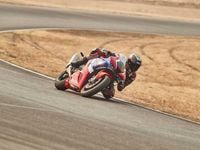
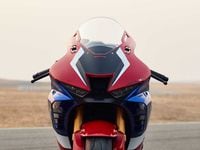
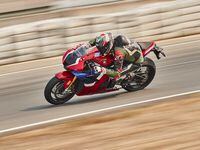
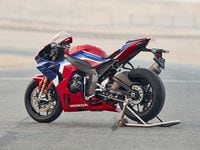

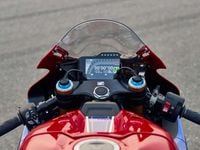


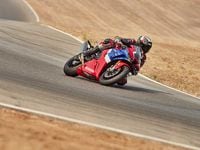


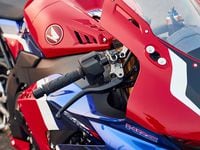

/cloudfront-us-east-1.images.arcpublishing.com/octane/7GJYDUIPXRGMTMQKN6ONYOLBOU.jpg)
/cloudfront-us-east-1.images.arcpublishing.com/octane/MUQLOVLL2ZDGFH25ILABNBXKTI.jpg)
/cloudfront-us-east-1.images.arcpublishing.com/octane/TNOU5DNE2BC57MFPMGN2EIDXAM.jpg)
/cloudfront-us-east-1.images.arcpublishing.com/octane/GTCXACQGJ5HAPDTGWUQKDEH44E.jpg)
/cloudfront-us-east-1.images.arcpublishing.com/octane/S35YGSEMEZB4BLTDJTSZPF4GLA.jpg)
/cloudfront-us-east-1.images.arcpublishing.com/octane/5UOT6HPX2JFMRJAX6EH45AR4MQ.jpg)
/cloudfront-us-east-1.images.arcpublishing.com/octane/OKWOJWAKP5EP3OACCRRWPCIX2Q.jpg)
/cloudfront-us-east-1.images.arcpublishing.com/octane/2WF3SCE3NFBQXLDNJM7KMXA45E.jpg)
/cloudfront-us-east-1.images.arcpublishing.com/octane/G4MG6OUCJNBSHIS2MVVOTPX65E.jpg)
/cloudfront-us-east-1.images.arcpublishing.com/octane/IIGGWFOTOJGB7DB6DGBXCCMTDY.jpg)
/cloudfront-us-east-1.images.arcpublishing.com/octane/QSTCM6AVEZA5JJBUXNIQ3DSOF4.jpg)
/cloudfront-us-east-1.images.arcpublishing.com/octane/U4I7G625B5DMLF2DVIJDFZVV6M.jpg)
/cloudfront-us-east-1.images.arcpublishing.com/octane/B6XD6LS6IVCQPIU6HXDJSM3FHY.jpg)
/cloudfront-us-east-1.images.arcpublishing.com/octane/ICL63FEDDRDTTMINYICCEYGMDA.jpg)
/cloudfront-us-east-1.images.arcpublishing.com/octane/FCGZHQXRBZFLBAPC5SDIQLVF4I.jpg)
/cloudfront-us-east-1.images.arcpublishing.com/octane/WNOB6LDOIFFHJKPSVIWDYUGOPM.jpg)

/cloudfront-us-east-1.images.arcpublishing.com/octane/X33NU3E525ECRHXLNUJN2FTRKI.jpg)
/cloudfront-us-east-1.images.arcpublishing.com/octane/6KKT5NNL2JAVBOXMZYS5ZO76YA.jpg)
/cloudfront-us-east-1.images.arcpublishing.com/octane/J5RKG5O455GMPGQRF2OG6LRT7A.jpg)
/cloudfront-us-east-1.images.arcpublishing.com/octane/GX2CIZKQVRH2TATDM26KFG2DAE.jpg)
/cloudfront-us-east-1.images.arcpublishing.com/octane/ZWIDYSAKQZHD5BHREMQILXJCGM.jpg)
/cloudfront-us-east-1.images.arcpublishing.com/octane/CYUHJZCTSJCH3MRAQEIKXK7SCQ.jpg)
/cloudfront-us-east-1.images.arcpublishing.com/octane/LKOFINY56FCXJCANJ5M7ZDQUBY.jpg)